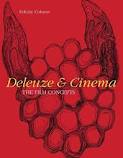| Felicity Colman, Deleuze and Cinema: The Film Concepts Oxford; New York: Berg, 2011 ISBN: 978-1-84788-053-6 US$29.95 (pb) 280pp (Review copy supplied by Berg) |
 |
Felicity Colman’s Deleuze and Cinema: The Film Concepts (2011) explores, as the author has done before, the relationship between cinema and philosophy. As the title suggests, this book looks specifically at Deleuze’s cinematic philosophy explored in his two works Cinema 1: The Movement-Image (1986) and Cinema 2: The Time-Image (1989). Colman’s book is another welcome addition to the recent influx of excellent English language literature that is available on Deleuze’s cinema books. It sits comfortably alongside other notable publications such as those by Gregory Flaxman, David Martin-Jones, Ronald Bogue, Paola Marrati, Barbara M Kennedy and Patricia Pisters (to name only a few). These authors all explore the different ways in which aspects of Deleuze’s cinematic philosophy may be considered. Like Bogue’s book Deleuze on Cinema (2003) – which explores some of the philosophical influences that surrounds Deleuze’s two cinema works -Colman’s book sets out to describe in further detail some of the key concepts and themes that arise from what she refers to in her book as the Deleuzian ciné-system. Together, both Bogue’s and Colman’s books would make excellent accompaniments to a first-time reader of Deleuze’s cinematic philosophy.
In Deleuze and Cinema: The Film Concepts Colman examines the Deleuzian ciné-system and presents Deleuze’s approach as a methodology that is useful not just to cinema, but expands it to all types of practices concerning screen media forms (1). In addition to the countless cinematic examples that Deleuze already uses, Colman selects new forms of media to examine, such as recent digital films. She selects key concepts in the Deleuzian ciné-methodology to discuss, and provides thematic chapters on each of theses concepts within the ciné-system. In a similar way to Deleuze’s claim in the preface to the French edition of Cinema 1, that his work on the cinema should not be seen as a history of cinema but a taxonomy of the images and the signs it produces (xix), Colman poses a similar taxonomy of Deleuze’s ciné-philosophy. Colman takes into account different screen media and a wider range of recent examples, and produces a theory that is applicable to any screen media that has the capacity for image, sound and movement.
Deleuze and Cinema: The Film Concepts is divided into fourteen chapters, each dedicated to a particular film concept present in Deleuze’s cinema books. Some of the concepts examined in the book are ciné-system, movement, montage, perception, affect, action, transemiotics, signs, time, politics and philosophy. Each chapter begins with a brief summary of the concept to be discussed and an explanation of the terminology to be used. The chapter is then broken into three subsections that examines specifically what is the concept; how the concepts is used; then finally the function of the concept. The strength of this book lies in its simple and easy to navigate structure. It is clearly written and would be useful as a quick reference tool whilst reading Deleuze’s cinema books.
Colman not only takes some of the key concepts such as time and movement in Deleuze’s ciné-philosophy and gives a detailed account, but also some of the overlooked (and equally important) ones such as topology, which are frequently referred to in Deleuze’s cinematic philosophy but never fully explained. I have already mentioned that this book would be useful to a first-time reader of Deleuze’s cinema books, but I believe that it has wider appeal. Its clear and concise structure makes it easy to use as a reference source. A more experienced reader of Deleuze would still find this book helpful, as its concise format makes it a useful resource to quickly refresh one’s memory on some of the many complex concepts that appear in the two books. In addition, it is a useful example of how Deleuze’s cinematic philosophy may be used in relation to twenty-first century forms of media. I enjoyed reading this book and think that it is a great new contribution to the discussion on Deleuze’s cinema books. I have just finished writing an honours thesis using Deleuze’s cinematic philosophy and now wish that I had the opportunity to read this book earlier. It would have simplified some aspects of my research, particularly around certain central concepts Deleuze refers to, but never fully explicates. Now that I have just started further research in the same area, I am predicting that Colman’s book will be well worn by the end of this second project!
References:
Ronald Bogue 2003, Deleuze on Cinema, London: Routledge, 2003.
Felicity Colman, Deleuze and Cinema: The Film Concepts, Oxford; New York: Berg, 2011.
Gilles Deleuze, Cinema 1: The Movement-Image, trans. H Tomlinson & B Habberjam, London: Continuum, 1986.
Gilles Deleuze, Cinema 2: The Time-Image, trans. H Tomlinson & R Galeta, London: Continuum, 1989.
